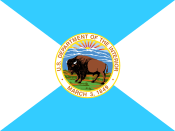 Seal of the U.S. Department of the Interior | |
 Flag of the U.S. Department of the Interior | |
 Exterior of the main Interior Building | |
| Agency overview | |
|---|---|
| Formed | March 3, 1849 |
| Type | Department |
| Jurisdiction | Federal Government of the United States |
| Headquarters |
38°53′40″N 77°02′33″W / 38.89444°N 77.04250°W |
| Employees | 67,026 |
| Annual budget | $17.6 billion (2022)[1] |
| Agency executives | |
| Website | doi |
The United States Department of the Interior (DOI) is an executive department of the U.S. federal government responsible for the management and conservation of most federal lands and natural resources. It also administers programs relating to Native Americans, Alaska Natives, Native Hawaiians, territorial affairs, and insular areas of the United States, as well as programs related to historic preservation. About 75% of federal public land is managed by the department, with most of the remainder managed by the Department of Agriculture's Forest Service.[2] The department was created on March 3, 1849. It is headquartered at the Main Interior Building, located at 1849 C Street NW in Washington, D.C.
The department is headed by the secretary of the interior, who reports directly to the president of the United States and is a member of the president's Cabinet. The current secretary is Deb Haaland.
As of mid-2004, the department managed 507 million acres (2,050,000 km2) of surface land, or about one-fifth of the land in the United States. It manages 476 dams and 348 reservoirs through the Bureau of Reclamation, 431 national parks, monuments, historical sites, etc. through the National Park Service, and 544 national wildlife refuges through the Fish and Wildlife Service. The largest land management agency is the Bureau of Land Management, managing about one-eighth of the land in the United States.
Despite its name, the Department of the Interior has a different role from that of the interior ministries of other nations, which are usually responsible for police matters and internal security. In the United States, national security and immigration functions are performed by the Department of Homeland Security primarily and the Department of Justice secondarily. The Department of the Interior has often been humorously called "the Department of Everything Else" because of its broad range of responsibilities.[3]
- ^ "Departmental Overview" (PDF). Archived (PDF) from the original on May 16, 2022. Retrieved May 25, 2022.
- ^ GAO, "Federal Land Management: Observations on a Possible Move of the Forest Service into the Department of the Interior" Archived July 3, 2017, at the Wayback Machine, February 11, 2009
- ^ "History" Archived August 14, 2015, at the Wayback Machine, National Park Service web page. Retrieved May 20, 2010.